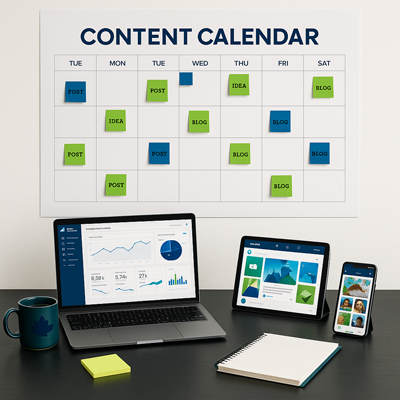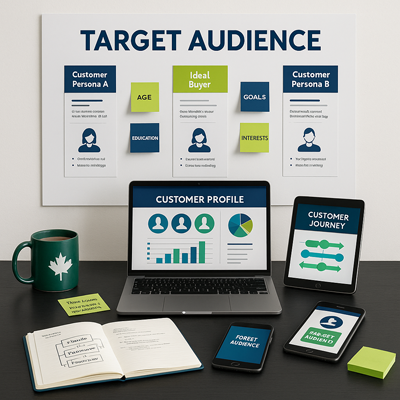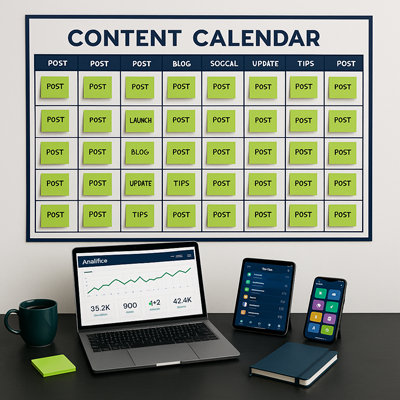Introduction: Why a Content Strategy Matters More Than Ever

Have you ever felt like your business is constantly creating posts, ads, or brochures but not seeing much return? You’re not alone. Many
Central Alberta business owners pour time into marketing without a clear plan, which leads to scattered efforts and missed opportunities.
The solution is a content marketing strategy. A framework
that ensures every blog, social post, email, and ad works together to move your business forward. With fall around the corner, now is
the perfect time to sharpen your approach so you’re not scrambling during the busy holiday season.
What Is a Content Marketing Strategy and Why Do You Need One?
A content marketing strategy is a step-by-step plan for how your business will use content. Blogs, videos, graphics, print materials, and
more can be used to attract and engage your target audience.
Instead of random posting, a strategy helps you:
- Clarify your goals (brand awareness, lead generation, or customer retention).
- Consistently deliver the right message to the right people.
-
Maximize your investment in marketing tools like printing services, custom signage, or branded
apparel.
In short, it saves time, builds consistency, and makes your marketing measurable.
Step 1: Define Your Business Goals
Ask yourself: What do I want my content to achieve in the next 3–6 months?
Examples include:
- Driving more traffic to your website.
- Increasing in-store visits in Lacombe, Red Deer, or Ponoka.
- Promoting a seasonal product line such as corporate swag or promotional products.
Set SMART goals (Specific, Measurable, Achievable, Relevant, Time-bound) to guide your content creation.
 Step
2: Understand Your Audience
Step
2: Understand Your Audience
Content that doesn’t speak to your audience will fall flat. To prevent this:
- Identify your ideal customer — their age, interests, challenges, and where they spend time online.
- Use tools like surveys, website analytics, or feedback from your sales team.
-
Consider seasonal timing. For example, parents in Central Alberta may be preparing for back-to-school in August and September, making this a
great time to focus on time-saving products or services.
Step 3: Choose the Right Content Channels
You don’t need to be everywhere — you just need to be where your audience is.
Common content channels include:
Match each channel to your goals and audience habits.
Step 4: Plan Your Content Themes
Themes keep your content consistent and recognizable. Examples:
- Seasonal campaigns (fall promotions, holiday gift guides).
- Educational topics (how-to blogs, checklists, or guides).
- Community highlights (showcasing partnerships with local organizations in Lacombe or Red Deer).
- Product spotlights (corporate gifts, branded apparel, or laser-engraved items).
A content calendar helps you spread these themes throughout the year without repeating yourself.
Step 5: Create a Content Calendar
Think of your calendar as your road map. It should include:
- Post dates and deadlines.
- The content format (blog, video, email, print, social).
- The call to action (shop now, book a consultation, download a guide).
For example:
- August: Blog on developing a content strategy (this post).
- September: Social campaign on fall signage for storefronts.
- October: Email campaign for early holiday orders of corporate gifts.
This approach keeps your team accountable and prevents last-minute stress.
Step 6: Produce Quality Content
Quality beats quantity every time. Here are some tips:
- Write at a Grade 8–10 reading level so your audience can understand quickly.
-
Incorporate visuals such as custom graphics, videos, or printed
materials,
to make your message stand out.
- Align everything with your brand management guidelines to build recognition.
- Consider professional support for design, copywriting, or video editing to free up your time.
Step 7: Promote and Distribute Your Content
Don’t let great content sit in a corner. Share it across multiple platforms:
- Post your blog on social media with engaging captions.
-
Print QR codes on rack cards, flyers, or postcards that link back to your website.
- Repurpose content by turning a blog into an infographic, or a webinar into a short video series.
Strand360 helps businesses in Central Alberta amplify their content with services ranging from signage design to corporate
swag
that carries your message further.
Step 8: Measure and Adjust
No strategy is complete without measurement. Track:
- Website visits and engagement.
- Social media interactions.
- Leads or sales generated from campaigns.
If something isn’t working, adjust. Marketing is about learning, testing, and refining.
Final Thoughts: Start Small, Stay Consistent
Building a content marketing strategy doesn’t have to feel overwhelming. Start with one clear goal, choose a few channels, and grow from
there. The key is consistency. Showing up with useful, engaging content that makes your business stand out in Alberta and across Canada.
If you’d like help building your strategy, the Strand360 team is ready to partner with you!
LET'S TALK CONTENT CREATION!
LET'S TALK CONTENT CREATION!


 Step
2: Understand Your Audience
Step
2: Understand Your Audience



